For beginners, flash photography might sound complicated.
Most of us start by capturing our subjects with sunlight. However, we quickly find out that natural light can be limiting.
What happens if it’s cloudy, if you want to photograph at night, or if the scene has a lot of contrast?
Having the option to add some flash light expands your possibilities – and it’s not as difficult as you might think.
You can use the flash to compensate for poor light or to create your artistic vision.
Whatever the situation, this article will give you all the information you need to get started, from the types of flashes to some tricks to practice at home.
If you’re ready, let’s get started!
Which camera flash is best?Table of Contents
ToggleWhat is Flash Photography?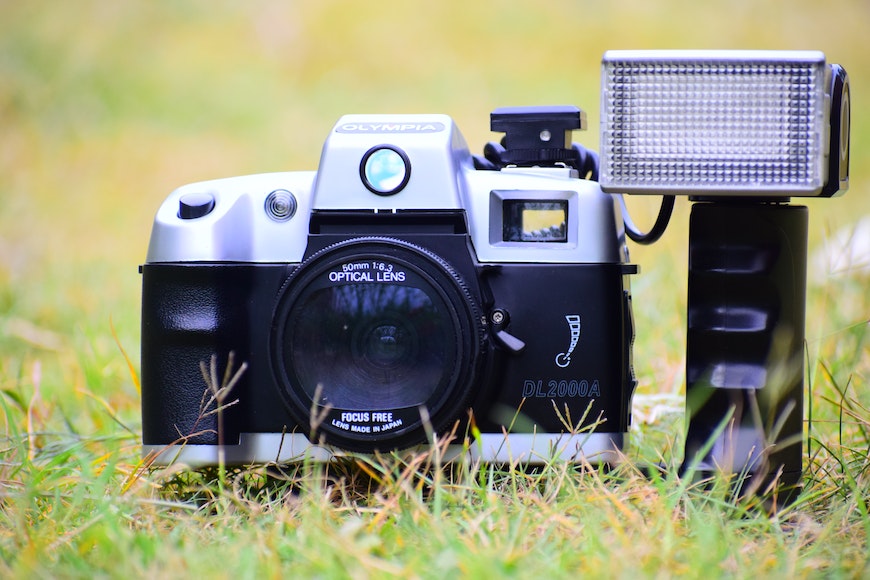
Credit: Tantray Junaid
Flash photography is any type of photography where you illuminate the scene or the subject with any device that emits a burst of light.
Such a device is a flash unit. This can be anything from the LED light on your camera phone to a studio monolight.
Nowadays, the most commonly used devices are electronic flash units, but this wasn’t always the case.
In fact, the first flash photographers literally risked their lives to get the picture.
Early flash photography was done by burning magnesium to create a bright, daylight-like light. This could be done using flat magnesium ribbon – first created by the Manchester Magnesium Company in 1864 – or with flash powder, a mixture of magnesium powder and potassium chlorate.
Flash powder was ignited by hand, a highly dangerous activity.
Then, in 1889, Joshua Cohen and Paul Boyer invented the flash lamp. It used electrical power to heat a wire fuse and ignite the flash powder to create a burst.
As you can imagine, this method was also quite dangerous. Photographers often got hurt while preparing the flash lamp.
Fortunately, by the end of the 1920s, a new technology came along: flash bulbs.
General Electric (GE) first commercialized these bulbs, which were filled with magnesium filaments and oxygen gas.
Their GE Mazda Type 75 – the largest flashbulb in history – was used for nighttime aerial photography in World War II.
In the 1960s, Kodak introduced the Flashcube, which allowed for four flash bulbs in one device. After each exposure, you only needed to turn the cube to use the remaining bulbs, instead of having to remove it each time.
When GE saw this, they came up with the Flip flash, which allowed the photographer to shoot up to ten images before needing to change it.
Different manufacturers came up with their versions, but the problem remained the same – each bulb was good just for one flash exposure.
That’s where electronic flashes came in.
In 1931, professor Harold Egerton invented the electronic flash tube. This is the base for all electronic flashes we use today.
The main characteristic is that these devices can store power for later use. Of course, in time, they’ve become faster and cheaper, improved the synchronization capacity, etc.
Thanks to this, we now find different types of flashes that fit all needs and budgets.
The final step in the evolution until today is the LED flash. Despite being used in cameras since the year 2000, they became popular thanks to smartphone photography.
Most camera phones have an LED light that flashes when you take a picture.
How to Quickly Fix the Flash on Your Phone or CameraWhat is Flash Photography Good For?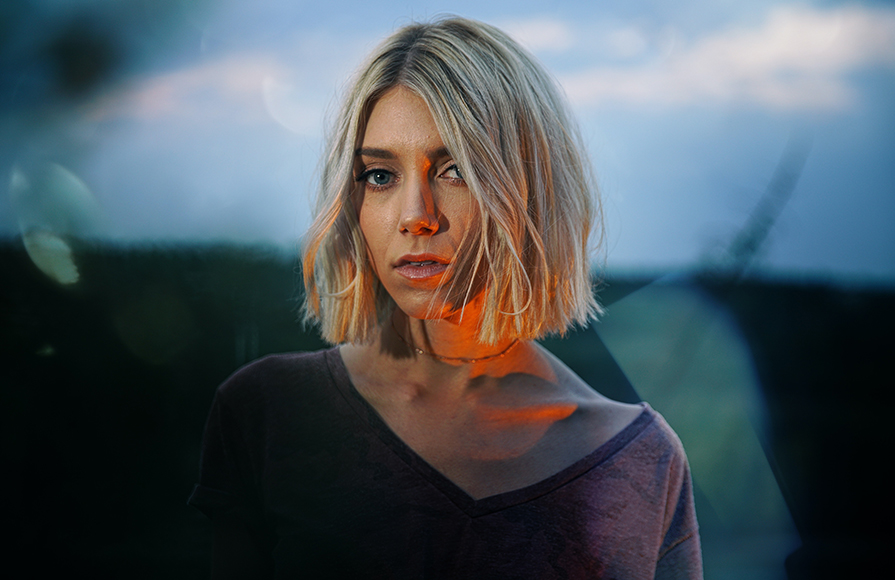
Credit: Travis Nesbitt
Flash photography is good for any photographic genre. Whether you use it all comes down to the light conditions and your creative style.
These are some of the most common situations when you would want to do flash photography:
When there isn’t enough light for the camera settings you want to use.When you want to freeze a moving subject.When you want to illuminate a subject in a dark scene.When you want to fill in the shadows created by another light source.Types of Flash in PhotographyI already mentioned that a flash could be anything from the tiny light on your phone to a big studio strobe. So, how many types of camera flashes are there?
Built-in flashMany cameras come with some sort of flash incorporated into the body. Whether this is a pop-up flash, LED flash, or another light source depends on the camera type.
For example, DSLRs have a pop-up flash, while camera phones have a LED flash. Even some disposable cameras have a light.
However, not all cameras have a built-in flash. This is commonly the case with mirrorless cameras.
Built-in flashes fire automatically when the camera is in auto mode, and there’s low light. You can also turn the flash on or off manually if the camera allows it.
Some even let you set it to fill mode, slow sync, red-eye mode, etc.
FlashgunThis type of electronic flash has many names. As a general device, it’s often referred to as on-camera flash or hot shoe flash.
There are some proprietary names for it too. The ones from Nikon are called Speedlights, while the Canon flashes are Speedlites.
These devices are light and portable. The flash fires with the shutter release.
They can also be triggered with a transmitter if they’re off-camera.
The more basic ones work manually and only allow you to control the intensity of the flash exposure.
Some more advanced ones have zoom control, high-speed sync, TTL and manual mode, etc.
Before investing in this type of flash, you need to make sure it’s compatible with your camera.
Setting up your camera flash is slightly different for each brand of camera/flash – here’s how to set up a flash for a Sony camera.
Ring flashThis type of electronic flash is shaped like a ring because it sits in front of the lens.
It provides soft flat lighting. This is why it’s commonly used in glamour and beauty photography.
It’s also ideal for macro photography. Because it sits in front of the lens, it won’t cast any shadows on a very close subject.
Flash HeadThese are professional lighting devices, also called strobes or monolights.
They’re usually used in the studio. They are larger and heavier than other types of flashes and need an electrical connection to function.
You can also use them if you’re shooting on location. However, because they require electrical power, you’ll either need a power pack or opt for a battery-powered flash head.
What lighting is best for studio photography?TTL vs Manual Flash: What’s the Difference?TTL is the automatic mode of your flash. It stands for Trough-the-Lens because the flash reads the ambient light coming through the lens and adjusts its power accordingly.
The reading happens through a pre-flash light which you’ve probably seen many times. It’s a short burst of light that happens just before the flash goes off.
On the other hand, using the manual flash requires you to adjust the settings for the flash exposure.
Using a manual flash, you need to set it 1/1 for full power flash. To decrease its power, you move in fractions.
To use the flash in manual mode, the camera needs to be in manual too.
You can use an external light meter to determine the flash exposure.
What Are Flash Modifiers?Flash modifiers are accessories that you can use to change the quality or direction of the light.
Some of the most common are:
Softbox: it turns hard light into diffused light.Reflector: you can use this to bounce light to soften it.Grid: it narrows the angle of the light beam.Color gels: they add a color tint to the light.4 Flash Photography Tips & IdeasIf you want to start using flash, here are some tips and ideas to help you out.
1. Get your flash photography settings right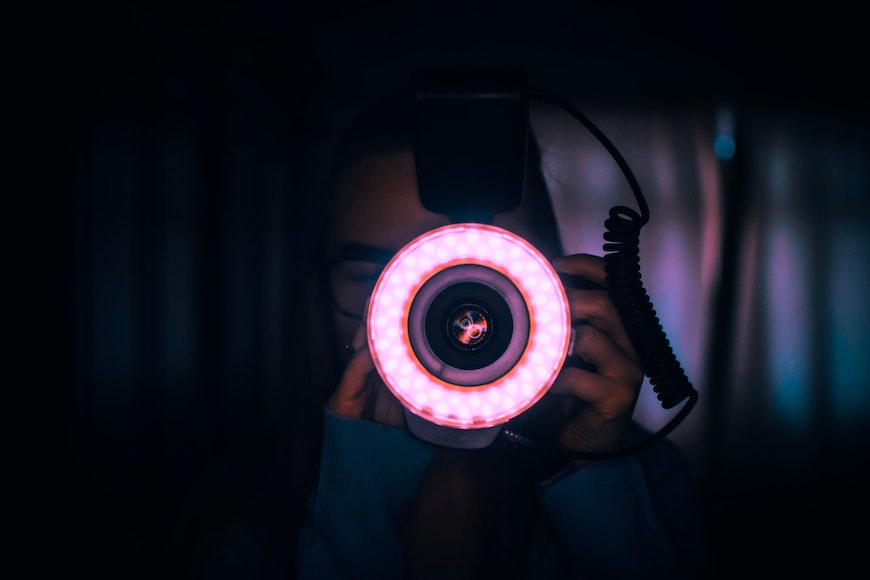
Credit: Lisa Fotios
You don’t need to worry if you’re using your flash in Auto or TTL mode. The flash will measure the available light and adjust the settings automatically.
In manual mode, you need to do this by yourself.
To get the settings right, start by putting the camera in manual mode too.
Set your ISO to 100. One of the advantages of using flash is that you don’t have to raise the ISO.
Then, set the shutter speed. Keep in mind that many cameras have a maximum sync speed of 1/200. So, don’t make it faster than that unless you know you have high-speed sync (HHS).
Remember that a slower shutter speed won’t make the subject brighter. That depends on the flash power.
If you leave the shutter speed open for longer, you’ll let in more ambient light.
Now, you can set the aperture. This determines how much light comes in and the depth of field.
Determine the DOF you want and adjust the flash power accordingly.
If you see that using those settings and the flash at full brightness isn’t enough, you’ll have to compensate. For example, you can raise the ISO or use a wider aperture.
2. How do you practice flash photography?
Credit: Wallace Chuck
To practice flash photography, you don’t need any specific subject. You can do it with a person or a product, or simply try to light a room.
Start by using the flash in manual mode and see how the camera settings change the results.
You can also try to balance the ambient light with the flash.
Finally, try using light modifiers to see how they work – check out our guide to the best softboxes, for example.
If you don’t have a big budget, there are many modifiers that you can DIY. For example, you can build a snoot with a can of Pringles, a grid with cardboard, and a ring light with a cake mold.
3. How can I make my flash pictures look natural?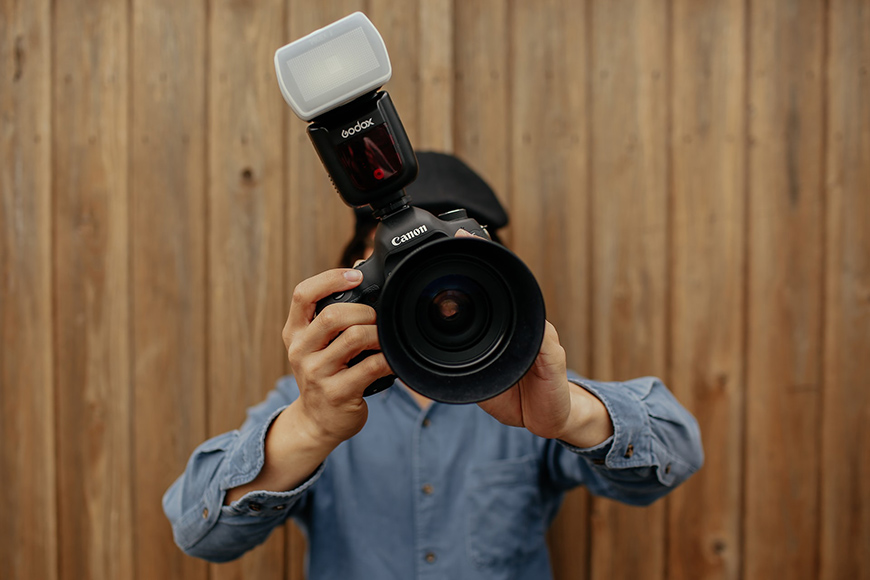
Credit: Tom Pumford
The natural look of images often has to do with the quality of the light. For example, a direct flash coming from the camera’s built-in flash is very obvious (and unflattering).
What you can do is bounce the light on a reflector or a bounce card.
Many flashguns have a bounce card built-in. You just have to pull it and secure it in place.
Then, find the right angle to light your subject’s face evenly.
Another trick to add a natural look to your images is to slow down the shutter speed. This allows for the ambient light to come through.
This technique isn’t possible with a moving subject. You should also use a tripod to avoid camera shake.
Finally, you need to use the right color temperature.
As you probably know, different lights have different colors expressed in Kelvin degrees.
Most flashes are calibrated to white light (approx. 5500°K), but you might want other settings. For example, if you want your shot to look like you took it at sunset, you need a color temperature of 3000-4000°K.
Learn more about photography lighting techniques4. What’s the best lens for flash photography?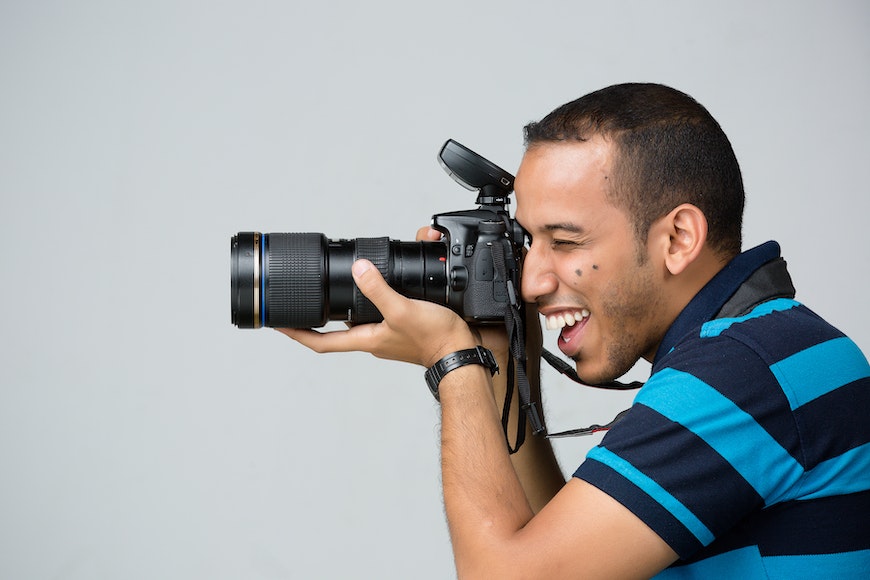
Credit: Antony Trivet
Flash photography is a category related to light, not the subject you capture. As such, the best lens you can use depends on what you’re photographing.
For example, a wide-angle lens may be best for interior photography if it’s a small space.
Instead, a short telephoto lens might be the best for a portrait photograph.
Regardless of the lens, they’re both flash photography if you use a flash unit to illuminate them.
However, a couple of tips related to the lens might be useful when doing flash photography.
One tip is to use a lens hood when you position the flash on the side. This will prevent any light from entering the lens, creating unwanted flare.
The next tip regards the pop-up flash. The built-in flash often creates a shadow if the lens is too long or you’re using a lens hood.
You can solve this by changing to an on-camera flash. Because it’s taller, this problem is avoided.
Just note that this might not be enough if the lens is long and you’re focusing on something close to you. In this case, you might want to use a ring flash that fits at the end of the lens.
Otherwise, use off-camera flashes.
If you don’t have any, you’ll need a more drastic solution. For example, zooming beyond the shadow, using the available light, or changing the lens.
Flash Photography FAQsShould I use flash for indoor photography?
If there isn’t enough ambient light, a flash can be a solution for shooting indoors. However, it’s not a must. Plenty of indoor photography is done with ambient or natural light.
Window lighting is one of the most popular ways to light indoor lifestyle portraits. It’s also common to use it in food photography and still life. Other photographers prefer to use continuous artificial light.
Do you use flash for newborn photography?
Natural light is the best option for newborn photography, but unfortunately, this isn’t always an option. If you need to use artificial light, consider continuous lighting. If you prefer to use flash, avoid using the built-in flash. It’s better to use an external flash device that lights the newborn from the side. Harsh light could wake the baby or even hurt its eyes, so use diffused light and regulate the light intensity.
Do you need a flash for portrait photography?
You don’t need to use flash equipment for portrait photography. That said, it is a very common choice. Usually, it’s used to illuminate the subject’s face when there are low light conditions. It can also be used to create a more complex lighting setup with multiple flashes.
Flash in outdoor portrait photography is useful when there’s bad weather, or you need complete control of the light.
Do you use flash for concert photography?
Usually, you can’t use a flash while taking photographs during a concert. This ban can come from the venue or the artist. Instead, a concert photographer knows how to work with the light on stage.
Since the artists on stage are constantly moving, it’s helpful to have a fast lens and a camera that tolerates high ISO values without rendering much noise. That way, you can still get good shots without the use of a flash.
Do you use flash for wedding photography?
There isn’t a hard and fast rule about using flash in wedding photography. Essentially, if you need it, use it.
The need for flash will depend on the time of the wedding and the event venue. If there isn’t enough ambient light to get a good image, then you should consider using flash lighting.
While flash photography can sometimes be disruptive – for example, during a church ceremony – it’s better than ending up with blurry photos due to a long exposure or noisy images due to a high ISO.
Do you need a flash for real estate photography?
You may or may not need flash for real estate photography – it all depends on the available light. However, the correct use of flash can differentiate a photo from a professional photographer from one taken by a realtor.
You can use a flash in real estate photography to even out the lighting. This is often needed between the bright area close to a window and the darker area that’s further away. You might also need a flash to fill the shadows cast by the furniture.
A common technique is using a flashgun to illuminate different room parts, then composing a photo with the perfect exposure using all the images.
What flash is best for macro photography?
The best option for macro photography is a ring flash. This is because an on-camera flash can cast the shadow of your lens on your subject.
Some macro lenses even come with a built-in ring light. The Canon EF-S 35mm f/2.8 is one example.
There are other good solutions for macro shots as well, like using flash tubes on the side. You can buy ring mounts with fixed or detachable flash heads for this type of lighting.
Which flash is best for outdoor photography?
The on-camera flash is the most practical way to work outdoors. This is because they are compact and lightweight and they also have a battery inside, so you don’t need to bring any extra power packs.
You can also use them off-camera using a transmitter and a receptor, which allows you to better position the light. You may also use multiple lights for your shot.
If these flashes don’t provide enough power, you might need a battery-powered flash head.
Final WordsAs you can see, flash photography has come a long way since the days of dangerous flash powder. Now, it’s an essential thing for any photographer to learn if you want to know how to control the light to create the images that you want.
Flash power can help you to achieve the desired lighting effect. For example, if you want to simulate daylight during the evening.
You won’t depend on the weather, the time of day, or the location.
On top of that, it’s also a great way to expand your creative possibilities and move into different genres.
Even if your preference is for natural light, it’s helpful to at least learn the basics of flash lighting.
Let us know in the comments how you feel about flash photography. What type of flash do you use, and what type of shots do you take?
Feel free to share any flash lighting tips and ideas and any questions you might have. Let’s keep the conversation going!
XFacebookPinterestShare Highly Recommended 8 Tools for Photographers
8 Tools for Photographers Check out these 8 essential tools to help you succeed as a professional photographer.
Includes limited-time discounts.
Learn more here